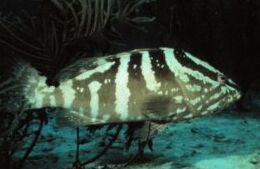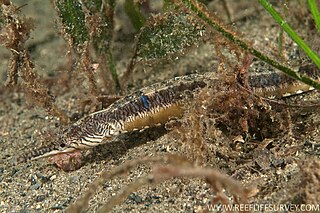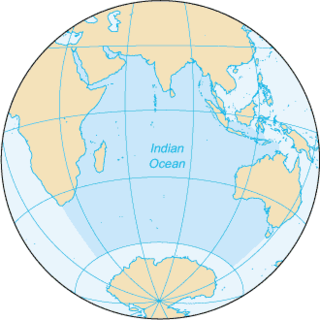
"Sardine" and "pilchard" are common names used to refer to various small, oily fish in the herring family Clupeidae. The term "sardine" was first used in English during the early 15th century and may come from the Mediterranean island of Sardinia, around which sardines were once abundant.

The Nassau grouper is one of the large number of perciform fishes in the family Serranidae commonly referred to as groupers. It is the most important of the groupers for commercial fishery in the West Indies, but has been endangered by overfishing.

The whitesaddled catshark is a species of catshark, and part of the family Scyliorhinidae. It is found on the upper continental slope of the western central Atlantic Ocean, off the coasts of Honduras, Panama and Colombia, between latitudes 22° N and 9° N, at depths between 274 and 457 m. It can grow to a length of 47 cm (19 in). The reproduction of this catshark is oviparous but otherwise, little is known about its biology. The International Union for Conservation of Nature has assessed its conservation status as "data deficient".

The southern sleeper shark or Whitley's sleeper shark is a deepwater benthopelagic sleeper shark of the family Somniosidae found in the southern Atlantic, Indian, and Pacific oceans. It is known from depths of 400 to 1,100 m. Its length is up to 4.4 m (14 ft). It feeds primarily on cephalopods, especially the colossal squid, and fish; its stomach contents also less commonly contain remains of marine mammals and birds. Based on its generally sluggish nature and the speed of its prey, it is thought to be an ambush predator. A 3.6-m-long female caught off the coast of Chile had a whole southern right whale dolphin in its stomach. This dogfish is sometimes taken as bycatch in the orange roughy and Patagonian toothfish fisheries; whether this poses a threat to the species is currently unknown.
The tenspine grouper is a species of marine fish, a grouper in the Serranidae family. It is found along the western coast of Mexico and Central America, but is a very rare fish of which little information exists. Largest known specimen was 125 cm long.

The camouflage grouper is a species of marine fish in the family Serranidae.

The Hawaiian grouper is a species of marine fish in the family Serranidae. It is large inquisitive inhabitant endemic to the Hawaiian Archipelago and Johnston Island.

Hypseleotris cyprinoides, the tropical carp-gudgeon or tropical bitterling-gudgeon, is a species of fish in the family Eleotridae found in fresh, brackish, and marine coastal waters from Africa through southern Asia to the Pacific Islands. This amphidromous species can reach a length of 8 cm (3.1 in). It has been extirpated from the Indian Ocean island of Réunion,

The messmate pipefish is a species of marine fish in the family Syngnathidae. It is widespread throughout the tropical waters of the Indo-Pacific region, from the eastern coast of Africa to the Vanuatu Islands. This species can reach a length of 19.8 cm. It occasionally makes its way into the aquarium trade where it is known as the dragonfaced pipefish. Other common names are bloodspot pipefish, reef pipefish, reeftop pipefish and yellow-streaked pipefish.

Darkflank pipefish is a pipefish species which inhabits the north-western Adriatic. It is found both in marine and brackish habitats. It is a demersal fish in which the males are ovoviviparous. It grows up to 19 centimetres (7.5 in) in length. It is found mostly amongst detritus or vegetation on the shallow muddy bottom.
Syngnathus macrophthalmus is a pipefish species, found only around Suez and Hurghada in the northwestern Red Sea. It is a marine tropical demersal fish, up to 12.2 centimetres (4.8 in) total length.

The ribboned pipefish, ribboned pipehorse or ribboned seadragon, is a species of pipefish found along the coast of northern Australia and New Guinea in habitats ranging from shallow and weedy to deeper and sandy bottoms down to depths of 16.5 m (54 ft). This species grows to a total length of 30 cm (12 in). Their colors can range from greenish yellow to brownish red. This species is the only known member of its genus.

The tiger pipefish is a species of pipefish native to the marine waters around Australia at depths of from 2 to 27 metres. This species grows to a length of 29.6 centimetres (11.7 in) SL. This species is the only known member of its genus.

Bryaninops erythrops, known commonly as the translucent coral goby or Erythrops goby , is a species of marine fish in the family Gobiidae.

Nemateleotris helfrichi, Helfrich's Dartfish, is a species of dartfish native to the Pacific Ocean.
Bhanotia pauciradiata is a little known marine fish of the family Syngnathidae. This species is only known from a single specimen, which was found on a reef slope near Indonesia, at a depth of around 10–12 m. The specimen was 3.2 centimetres (1.3 in) long. This species is ovoviviparous, with the male carrying eggs in its brood pouch until giving birth to live young.
Bryx dunckeri is a species of pipefish of the family Syngnathidae. It is found in the western Atlantic Ocean, from North Carolina to Florida and the Bahamas, in the Gulf of Mexico, and off South America to Macau, Brazil. It inhabits shallow waters ({{convert|1-30|m|ft) above algae and rock, both in estuaries and seagrass beds. It primarily feeds on benthic invertebrates such as crabs and molluscs, and can grow to lengths of 10 centimetres (3.9 in). This species is ovoviviparous, with the males carrying eggs until they are ready to hatch.
Bryx randalli, the ocellated pipefish, is a species of marine fish of the family Syngnathidae. It is found in the western Atlantic in the Caribbean Sea, where it inhabits the shallow subtidal zone to depths of 30m. It feeds on benthic invertebrates such as crabs and molluscs, and is less than 10 cm long. This species is ovoviviparous, with the males carrying the eggs in their brood pouch until they hatch.
Bryx veleronis is a species of marine fish of the family Syngnathidae. It is found in the Eastern Pacific, off the coasts of Mexico, Costa Rica, Panama, Malpelo Island (Colombia), and the Galápagos Islands (Ecuador). There is very little known about this species, but it is thought to inhabit depth ranges of roughly 30-40m, grow to lengths of 6 cm, and consume small crustaceans. It is ovoviviparous, with males carrying eggs in a brood pouch until they hatch.
















